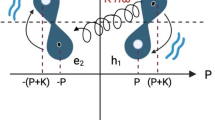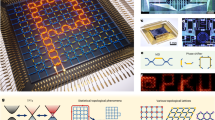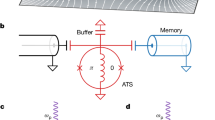Abstract
As with classical computers, quantum computers require error-correction schemes to reliably perform useful large-scale calculations. The nature and frequency of errors depends on the quantum computing platform, and although there is a large literature on qubit-based coding, these are often not directly applicable to devices that store information in bosonic systems such as photonic resonators. Here, we introduce a framework for constructing quantum codes defined on spheres by recasting such codes as quantum analogues of the classical spherical codes. We apply this framework to bosonic coding, and we obtain multimode extensions of the cat codes that can outperform previous constructions but require a similar type of overhead. Our polytope-based cat codes consist of sets of points with large separation that, at the same time, form averaging sets known as spherical designs. We also recast concatenations of Calderbank–Shor–Steane codes with cat codes as quantum spherical codes, which establishes a method to autonomously protect against dephasing noise.
This is a preview of subscription content, access via your institution
Access options
Access Nature and 54 other Nature Portfolio journals
Get Nature+, our best-value online-access subscription
$29.99 / 30 days
cancel any time
Subscribe to this journal
Receive 12 print issues and online access
$209.00 per year
only $17.42 per issue
Buy this article
- Purchase on Springer Link
- Instant access to full article PDF
Prices may be subject to local taxes which are calculated during checkout

Similar content being viewed by others
Data availability
Coordinates of the polytopes used for our codes constitute the minimum dataset necessary to verify the results in this article. Unless otherwise noted, coordinates for each code were obtained from the references linked in the corresponding row of our code tables in the Supplementary Information. Otherwise, we provide the coordinates explicitly in the main text or the Supplementary Information. Explicit coordinates for any particular code are available upon request.
Code availability
MATHEMATICA notebooks generated during the current study are available from the corresponding author on request. Further details and references about spherical codes described in this manuscript are available at the Error-correction Zoo website at http://errorcorrectionzoo.org and via Github at http://github.com/errorcorrectionzoo.
References
Sun, L. et al. Tracking photon jumps with repeated quantum non-demolition parity measurements. Nature 511, 444–448 (2014).
Ofek, N. et al. Extending the lifetime of a quantum bit with error correction in superconducting circuits. Nature 536, 441–445 (2016).
Leghtas, Z. et al. Confining the state of light to a quantum manifold by engineered two-photon loss. Science 347, 853–857 (2015).
Touzard, S. et al. Coherent oscillations inside a quantum manifold stabilized by dissipation. Phys. Rev. X 8, 021005 (2018).
Grimm, A. et al. Stabilization and operation of a Kerr-cat qubit. Nature 584, 205–209 (2020).
Campagne-Ibarcq, P. et al. Quantum error correction of a qubit encoded in grid states of an oscillator. Nature 584, 368–372 (2020).
Flühmann, C. et al. Encoding a qubit in a trapped-ion mechanical oscillator. Nature 566, 513–517 (2019).
de Neeve, B., Nguyen, T.-L., Behrle, T. & Home, J. P. Error correction of a logical grid state qubit by dissipative pumping. Nat. Phys. 18, 296–300 (2022).
Sivak, V. V. et al. Real-time quantum error correction beyond break-even. Nature 616, 50–55 (2022).
Dahan, R. et al. Creation of optical cat and GKP states using shaped free electrons. Phys. Rev. X 8, 031001 (2023).
Cohen, J. & Mirrahimi, M. Dissipation-induced continuous quantum error correction for superconducting circuits. Phys. Rev. A 90, 062344 (2014).
Fukui, K., Tomita, A. & Okamoto, A. Analog quantum error correction with encoding a qubit into an oscillator. Phys. Rev. Lett. 119, 180507 (2017).
Fukui, K., Tomita, A., Okamoto, A. & Fujii, K. High-threshold fault-tolerant quantum computation with analog quantum error correction. Phys. Rev. X 8, 021054 (2018).
Guillaud, J. & Mirrahimi, M. Repetition cat qubits for fault-tolerant quantum computation. Phys. Rev. X 9, 041053 (2019).
Vuillot, C., Asasi, H., Wang, Y., Pryadko, L. P. & Terhal, B. M. Quantum error correction with the toric Gottesman–Kitaev–Preskill code. Phys. Rev. A 99, 032344 (2019).
Noh, K. & Chamberland, C. Fault-tolerant bosonic quantum error correction with the surface-Gottesman–Kitaev–Preskill code. Phys. Rev. A 101, 012316 (2020).
Chamberland, C. et al. Building a fault-tolerant quantum computer using concatenated cat codes. PRX Quantum 3, 010329 (2022).
Larsen, M. V., Chamberland, C., Noh, K., Neergaard-Nielsen, J. S. & Andersen, U. L. Fault-tolerant continuous-variable measurement-based quantum computation architecture. PRX Quantum 2, 030325 (2021).
Guillaud, J. & Mirrahimi, M. Error rates and resource overheads of repetition cat qubits. Phys. Rev. A 103, 042413 (2021).
Noh, K., Chamberland, C. & Brandão, F. G. Low-overhead fault-tolerant quantum error correction with the surface-GKP code. PRX Quantum 3, 010315 (2022).
Zhang, J., Wu, Y.-C. & Guo, G.-P. Concatenation of the Gottesman–Kitaev–Preskill code with the XZZX surface code. Phys. Rev. A. 107, 06248 (2023).
Régent, F.-M. L., Berdou, C., Leghtas, Z., Guillaud, J. & Mirrahimi, M. High-performance repetition cat code using fast noisy operations. Quantum 7, 1198 (2023).
Stafford, M. P. & Menicucci, N. C. Biased Gottesman–Kitaev–Preskill repetition. Phys. Rev. A 108, 052428 code (2023).
Lieu, S., Liu, Y.-J. & Gorshkov, A. V. Candidate for a passively-protected quantum memory in two dimensions. Preprint at https://doi.org/10.48550/arXiv.2205.09767 (2022).
Gouzien, E., Ruiz, D., Regent, F.-M. L., Guilland, J. & Sangouard, N. Computing 256-bit elliptic curve logarithm in 9 hours with 126133 cat qubits. Phys. Rev. Lett. 131, 040602 (2023).
Albert, V. V., Covey, J. P. & Preskill, J. Robust encoding of a qubit in a molecule. Phys. Rev. X 10, 031050 (2020).
Gottesman, D., Devoret, M.H., DiVincenzo, D.P., & Girvin, S.M. GKP retrospective & bosonic codes panel discussion. Byron Bay Quantum Computing Workshop https://youtu.be/-BTKUe-5Boo?si=lkodhDDJeh60AMpv (2021).
Gottesman, D. Opportunities and challenges in fault-tolerant quantum computation (2022).
Cochrane, P. T., Milburn, G. J. & Munro, W. J. Macroscopically distinct quantum-superposition states as a bosonic code for amplitude damping. Phys. Rev. A 59, 2631 (1999).
Leghtas, Z. et al. Hardware-efficient autonomous quantum memory protection. Phys. Rev. Lett. 111, 120501 (2013).
Conway, J. H. &, Sloane, N. J. A. Sphere Packings, Lattices and Groups Grundlehren der mathematischen Wissenschaften, Vol. 290 (Springer, 1999).
Ericson, T. & Zinoviev, V. Codes on Euclidean Spheres, Vol. 63 (North Holland Mathematical Library, 2001).
Pedernales, J. S., Cosco, F. & Plenio, M. B. Decoherence-free rotational degrees of freedom for quantum applications. Phys. Rev. Lett. 125, 090501 (2020).
Cerf, N. J., Leuchs, G. & Polzik, E. S. Quantum Information with Continuous Variables of Atoms and Light (Imperial College Press, 2007).
Serafini, A. Quantum Continuous Variables: A Primer of Theoretical Methods (CRC Press, 2017).
Denys, A. & Leverrier, A. The 2t-qutrit, a two-mode bosonic qutrit. Quantum 7, 1032 (2023).
Schlegel, D. S., Minganti, F. & Savona, V. Quantum error correction using squeezed Schrodinger cat states. Phys. Rev. A 106, 022431 (2022).
Xu, Q. et al. Autonomous quantum error correction and fault-tolerant quantum computation with squeezed cat qubits. npj Quantum Inf. 9, 78 (2022).
Hillmann, T. & Quijandría, F. Quantum error correction with dissipatively stabilized squeezed cat qubits. Phys. Rev. A 107, 032423 (2022).
Albert, V. V. et al. Pair-cat codes: autonomous error-correction with low-order nonlinearity. Quantum Sci. Technol. 4, 035007 (2019).
Gross, J. A. Encoding a qubit in a spin. Phys. Rev. Lett. 127, 010504 (2021).
Turchette, Q. A. et al. Decoherence and decay of motional quantum states of a trapped atom coupled to engineered reservoirs. Phys. Rev. A 62, 053807 (2000).
Grimsmo, A. L., Combes, J. & Baragiola, B. Q. Quantum computing with rotation-symmetric bosonic codes. Phys. Rev. X 10, 011058 (2020).
Knill, E. & Laflamme, R. Theory of quantum error-correcting codes. Phys. Rev. A 55, 900 (1997).
Coxeter, H. S. M. Regular Polytopes 3rd edn (Dover Publications, 1973).
Shephard, G. C. Regular Complex Polytopes. P. Lond. Math. Soc. s3-2, 82 (1952).
Coxeter, H. S. M. Regular Complex Polytopes 2nd edn (Cambridge Univ. Press, 1991).
Sidelnikov, V. On a finite group of matrices and codes on the Euclidean sphere. Probl. Inform. Transm. 33, 29 (1997).
Sidelnikov, V. On a finite group of matrices generating orbit codes on Euclidean sphere. In Proc. IEEE International Symposium on Information Theory 436 (IEEE, 1997).
Sidelnikov, V. Spherical 7-designs in 2n-dimensional Euclidean space. J. Algebraic Comb. 10, 279 (1999).
Nebe, G., Rains, E. M. & Sloane, N. J. A. The invariants of the Clifford groups. Des., Codes Cryptogr. 24, 99 (2001).
Delsarte, P., Goethals, J. M. & Seidel, J. J. Spherical codes and designs. Geom. Dedicata 6, 363 (1977).
Roy, A. & Suda, S. Complex spherical designs and codes. J. Comb. Des. 22, 105 (2014).
Mohammadpour, M. & Waldron, S. Complex spherical designs from group orbits (2023).
Schumacher, B. Sending entanglement through noisy quantum channels. Phys. Rev. A 54, 2614 (1996).
Reimpell, M. & Werner, R. F. Iterative optimization of quantum error correcting codes. Phys. Rev. Lett. 94, 080501 (2005).
Fletcher, A. S., Shor, P. W. & Win, M. Z. Optimum quantum error recovery using semidefinite programming. Phys. Rev. A 75, 012338 (2007).
Fletcher, A. S., Shor, P. W. & Win, M. Z. Channel-adapted quantum error correction for the amplitude damping channel. IEEE Trans. Inf. Theory 54, 5705 (2008).
Albert, V. V. et al. Performance and structure of single-mode bosonic codes. Phys. Rev. A 97, 032346 (2018).
Calderbank, A. R. & Shor, P. W. Good quantum error-correcting codes exist. Phys. Rev. A 54, 1098 (1995).
Steane, A. M. Error correcting codes in quantum theory. Phys. Rev. Lett. 77, 793 (1996).
Steane, A. Multiple-particle interference and quantum error correction. Proc. R. Soc. A 452, 2551 (1996).
Puri, S. et al. Bias-preserving gates with stabilized cat qubits. Sci. Adv. 6, eaay5901 (2020).
Mirrahimi, M. et al. Dynamically protected cat-qubits: a new paradigm for universal quantum computation. New J. Phys. 16, 045014 (2014).
Goto, H. Bifurcation-based adiabatic quantum computation with a nonlinear oscillator network: toward quantum soft computing. Sci. Rep. 6, 21686 (2016).
Puri, S., Boutin, S. & Blais, A. Engineering the quantum states of light in a Kerr-nonlinear resonator by two-photon driving. npj Quantum Inf. 3, 18 (2017).
Girvin, S. M. Introduction to quantum error correction and fault tolerance. In SciPost Phys. Lect. Notes 70 https://doi.org/10.21468/SciPostPhysLectNotes.70 (SciPost, 2023).
Lescanne, R. et al. Exponential suppression of bit-flips in a qubit encoded in an oscillator. Nat. Phys. 16, 509 (2020).
Slepian, D. Group codes for the Gaussian channel. Bell Syst. Tech. J. 47, 575 (1968).
Loeliger, H.-A. Signal sets matched to groups. IEEE Trans. Inform. Theory 37, 1675 (1991).
Mittelholzer, T. & Lahtonen, J. Group codes generated by finite reflection groups. IEEE Trans. Inform. Theory 42, 519 (1996).
Sloane, N. et al. Spherical codes. http://neilsloane.com/packings/ (2000).
Ballinger, B. et al. Experimental study of energy-minimizing point configurations on spheres. Exp. Math. 18, 257 (2009).
Cameron, P., Goethals, J. & Seidel, J. Strongly regular graphs having strongly regular subconstituents. J. Algebra 55, 257 (1978).
Waldron, S. F. D. An Introduction to Finite Tight Frames Applied and Numerical Harmonic Analysis (Springer, 2018).
Bajnok, B. Construction of designs on the 2-sphere. Eur. J. Comb. 12, 377 (1991).
Reznick, B. Some constructions of spherical 5-designs. Linear Algebra Appl. 226–228, 163–196 (1995).
Xiang, Z. Explicit spherical designs. J. Algebr. Comb. 5, 347 (2022).
Coxeter, H. S. M. & Shephard, G. C. Portraits of a family of complex polytopes. Leonardo 25, 239 (1992).
Acknowledgements
We thank F. Arzani, A. Burchards, J. Conrad, A. Denys, P. Faist, M. Gullans, W. He, L. Jiang, G. Kuperberg, G. Lee, A. Leverrier, P. Panteleev, S. Singh and G. Zheng for helpful discussions. V.V.A. is especially grateful to K. Noh for discussion about realizations of these codes. This work is supported in part by NSF grants OMA-2120757 (QLCI), CCF-2110113 (NSF-BSF), CCF-2104489 and CCF-2330909. J.T.I. thanks the Joint Quantum Institute at the University of Maryland for support through a JQI fellowship. Our figures were drawn using MATHEMATICA 13 following the prescription of ref. 79. Contributions to this work by NIST, an agency of the US government, are not subject to US copyright. Any mention of commercial products does not indicate endorsement by NIST. V.V.A. thanks R. Kandratsenia, Tatyana Albert, Thomas Albert and O. Albert for providing daycare support throughout this work.
Author information
Authors and Affiliations
Contributions
All authors contributed extensively to the work presented in this paper.
Corresponding author
Ethics declarations
Competing interests
The authors declare no competing interests.
Peer review
Peer review information
Nature Physics thanks Michael Vasmer and the other, anonymous, reviewer(s) for their contribution to the peer review of this work.
Additional information
Publisher’s note Springer Nature remains neutral with regard to jurisdictional claims in published maps and institutional affiliations.
Supplementary information
Supplementary Information
Supplementary Figs. 1–2, Tables 1–5 and Discussion.
Rights and permissions
About this article
Cite this article
Jain, S.P., Iosue, J.T., Barg, A. et al. Quantum spherical codes. Nat. Phys. (2024). https://doi.org/10.1038/s41567-024-02496-y
Received:
Accepted:
Published:
DOI: https://doi.org/10.1038/s41567-024-02496-y



